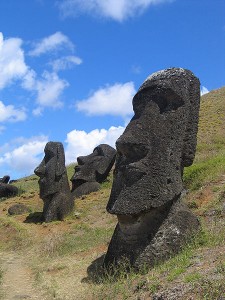 On the day after Easter, it’s fitting that we visit Easter Island. This remote Chilean territory was discovered and named on Easter Sunday, 1722 by a Dutch explorer. Easter Island has captured the world’s imagination for centuries, due to its mysterious cultural practices and abundance of strange monolithic statues.
On the day after Easter, it’s fitting that we visit Easter Island. This remote Chilean territory was discovered and named on Easter Sunday, 1722 by a Dutch explorer. Easter Island has captured the world’s imagination for centuries, due to its mysterious cultural practices and abundance of strange monolithic statues.
The famous “Easter Island heads” or Moai are large stone statues that were created by the indigenous people as representations of their ancestors. To date, 877 Moai have been found. The largest statue weighs 82 tons and is 32 feet long. A team of 5 or 6 men probably took a year to carve this statue out of the local lava rock using simple stone hand chisels. Then, it would have taken up to 250 men to pull the giant statue down from the mountain and set it in place overlooking the sea.
A lesser known fact about Easter Island is that it is the only Polynesian culture (that we know of) to have produced a written alphabet. The Easter Island script is called Rongorongo, and it was written on wood tablets. Easter Island is also known for its large collection of petroglyphs.
Much of Easter Island’s history and culture has been lost, due to repeated disasters and population loss on the island. The original inhabitants were Polynesians who came to the island by canoe sometime between 700 and 1100. Evidence suggests that when humans first arrived, the island had plenty of trees, including some of the tallest palm species in the world. Yet when Europeans arrived in 1722, the tall trees were gone and the island’s population was estimated at just 3,000 people. In the centuries that followed, the island continued to lose population due to slaving, smallpox, and tuberculosis epidemics. By 1877, only 111 people remained on Easter Island.
Chile annexed Easter Island in 1888. The indigenous inhabitants were not given citizenship until 1966.